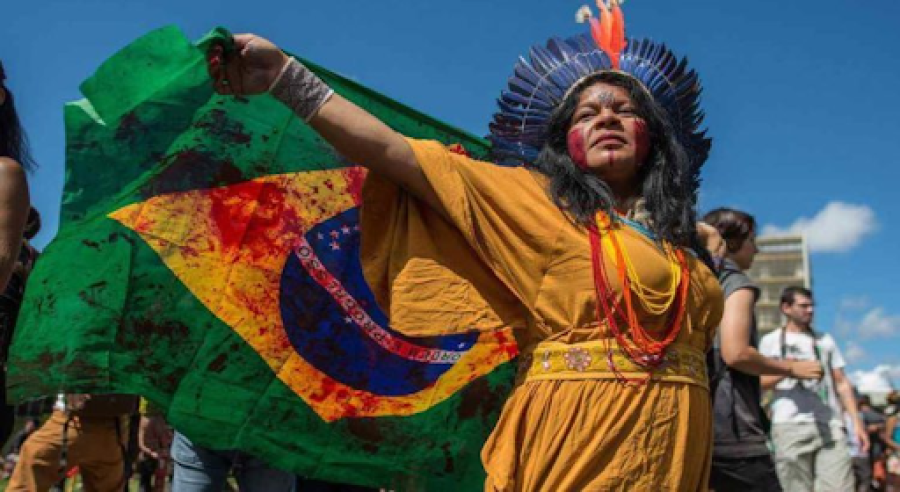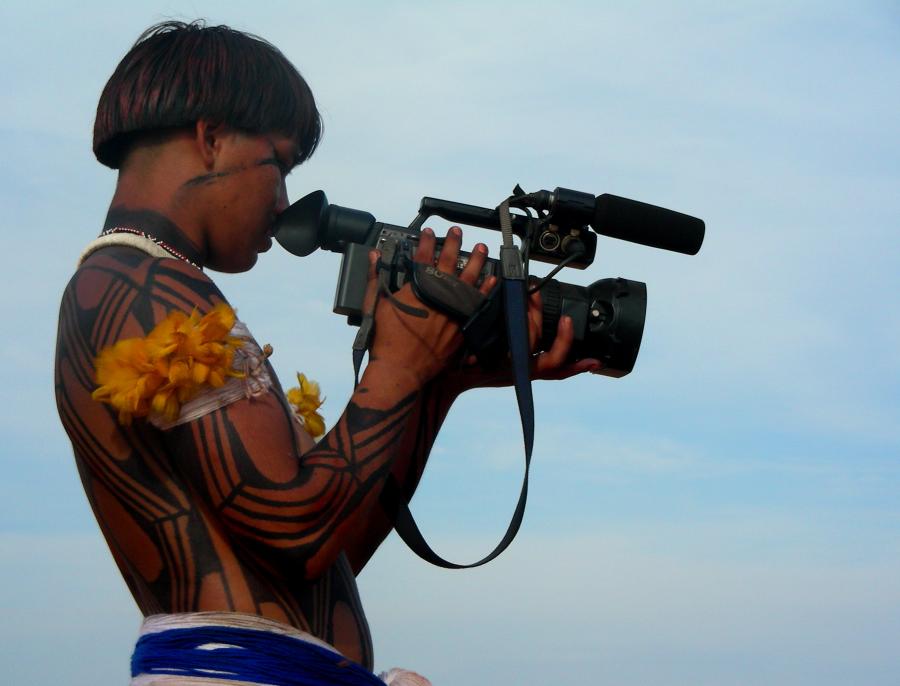Kayapó Plan Meeting to Discuss Dams
An unprecedented attempt by Amazonian Indians to organize themselves to resist (by peaceful legal and political means) the destruction of their forest habitat and the expropriation of their traditional lands is now under way in the forests and native villages of central Brazil. This attempt, conceived by the leadership of the Kayapó tribe and joined by some 28 other tribal peoples of the central Amazonian region, focuses of the construction of a great intertribal village of 3,000 people in the path of the proposed Altamira hydroelectric dam complex. The dam would flood more than 1,600 sq. km of forest land to become the largest manmade lake in the world. At the great council to be help upon the completion and occupation of the village, scheduled from 21-26 February, the Indians will form an enduring organization that will work with Brazilian and foreign supporters committed to saving the forest, its animals and native peoples. A Kayapó leader, Paiakan, has just completed a seven-country tour of Europe and North America to generate support and raise money for this project.
Over the last several years, the great Amazonian forest (which includes the world's largest rain forest and one-third of the earth's surviving forest area) has been under concerted attack. Every year settlers, miners, ranchers and workers on hydroelectric projects, all actively encouraged or instituted by the Brazilian government's ecologically disastrous "development" policies, destroy vast areas of virgin forest habitat. Ecological scientists from all over the globe have warned of the catastrophic consequences of the destruction of the world's remaining tropical forests. These consequences range from the global warming, or "greenhouse" effect, through the depletion of oxygen levels in the atmosphere, to the loss of roughly one-half of the zoological and botanical species of life on earth.
The Amazon is also the home of perhaps the greatest number of surviving primitive human societies (only Papua New Guinea comes close). The native societies are mostly small, with communities often numbering less than 100 people scattered over vast areas of forest. Most of them were ill prepared to withstand the onslaught of the national societies and international development projects that have penetrated the area in increasing force since the late '60s. Many observers since that time have predicted the rapid disappearance of these tribal communities as an inevitable corollary of the destruction of their forest world by the inexorable advance of Western civilization. Now, some of these tribal groups are not only becoming effective forces on their own behalf in the battle to save their lands and environment, but are organizing this struggle in the world at large.
Despite the many gloomy prognostications of cultural and even physical extinction, there have been a number of instances of demographic, social and political resurgence among native Amazonian peoples over the past 20 years. Native populations have on the whole ceased to decline and begun again to grow. Illegally expropriated lands have in several cases been reoccupied, and the Brazilian government induced to grant legal title. Native leaders have won election to the National legislative assembly and gained high administrative office in the National Indian Foundation (FUNAI). The effect of these events has been amplified by extensive coverage in local and international news media, often skillfully arranged by the Indians themselves. As more Indians learn paramedical care and mechanical maintenance, they elevate their general state of health and their level of effective control over their own lives.
Leading this dramatic resurgence of Amazonian Indians has been the Kayapó tribe of southern Pará state, a nation of some 14 separate communities with a tradition of political organization and oratory that has stood them in good stead in the contemporary crisis. Within the past six years the Kayapó have organized successful demonstrations in Brasília against the dumping of radioactive waste on their land, against government attempts to deny their rights of free speech, travel and assembly and against clauses damaging to Indians in Brazil's new Constitution. They drove illegal settlers from one major area of their ancestral territory and induced the government to grant them legal title to it; in another area, they recaptured two gold mines illegally opened on their land by Brazilian miners. In the latter case, they forced the national bank of Brazil to pay them a percentage of the profits, and took over the administration of the mines themselves until such time as they choose to close them down. The Altamira village has now become the focus for the conversion of this amazing series of local successes into a general, pantribal movement with a permanent organization.
Every one of the successful Kayapó actions was conceived and organized by a remarkable young leader named Paiakan. Last February, Paiakan and another Kayapó leader, Kube-i, traveled abroad to garner world support for their struggle to save their environment, their communities and lands. Accompanied by a American anthropologists, Darrell Posey, the two Kayapó came to Washington, DC, to speak to officials of the World Bank, the State Department and the Congress about the disastrous consequences of two huge dams for which the Brazilian government was seeking World Bank funding. The Bank subsequently deferred action on the loans, and the Brazilian government brought charges against the three under a law regulating political activity by foreigners. The case remains open, but an international outcry and effective demonstrations in support of Kube-i and Paiakan by the Kayapó themselves have rendered it unlikely that it will ever be brought to trail. (If found guilty, all three could be expelled from the country and/or jailed for three years).
These developments set the stage for the launching of the Altamira village project, publicly announced in Paiakan's second tour of North America and Europe in November and December 1988. In spite of the Brazilian government's attempts to intimidate and punish the Kayapó leaders for criticizing its Amazonian development policies (and particularly the huge Altamira hydroelectric complex) in sensitive foreign capitals, Paiakan undertook his tour last month. His general purpose was to bring the crisis of the environment and native peoples of the Amazon to wider public attention, to lobby governmental and international development bank officials against supporting economic development projects that would irreversibly damage the environment and expropriate native lands, and, more specifically, to appeal for support of the plan he and other Kayapó leaders have formed to enlist the native peoples of the region in the worldwide campaign to save their forest world: the construction of the Altamira village.
In his Chicago talks, Paiakan repeatedly stressed the need for cooperation and unity of purpose among the different organizations engaged in fighting the destruction of rain forests, native cultures and human rights in the Third World.
The forest is one big thing; it has people, animals, and plants. There is no point saving the animals if the forest is burned down; there is no point saving the forest if the people and animals who live in it are killed or driven away. The groups trying to save the races of animals cannot win if the people trying to save the forest lose; the people trying to save the Indians cannot win if either of the others lose; the Indians cannot win without the support of these groups; but the groups cannot win without the help of the Indians, who know the forest and the animals and can tell what is happening to them. No one of us is strong enough to win alone; together, we can be strong enough to win.
Many environmentalist, indigenous advocacy and human rights groups, such as Friends of the Earth, World Wildlife Federation, Rainforest Alliance, Survival International and Cultural Survival, began to cooperate in the organization and sponsorship of Paiakan's tour.
The Altamira village is to be the Indians' own "Altamira Project" - a living community to counter the drowned forest dead animals and homeless people that would be created by the Brazilians' Altamira Hydroelectric Project. There, the assembled Indians have invited a series of spokesperson for Brazilian governmental agencies, the World Bank and the president of Brazil to explain their reasons for building the dams and for not consulting the Indians themselves in their planning. The Indians will in turn present their arguments against the dams and other development policies now being put into effect in the region. At the same time, they will jointly celebrate the Kayapó New Corn Ceremony. The building of the common village and the common ritual celebration are intended as the first concerted political and social actions of a new alliance of indigenous nations of central Amazonia: the charter events, as it were, for future united acts in defense of their imperiled world. The creativity and boldness of this project are breathtaking; nothing like such a concerted action by unrelated Indian societies has ever taken place in the Amazon.
This great intertribal village would symbolically contrast the native way of life, with its emphasis on organic coexistence of society with nature, to the modern Western way of destroying nature and local society to generate energy and profit in distant regions. The common celebration of the Kayapó New Corn Ceremony, which symbolically renews native society's productive interdependence with its natural environment, is meant to dramatize this theme. The symbolic construction of the intertribal meeting as a total social community with families and collective agricultural ritual is means to signal the Indians' vision of the integral nature of the Amazonian crisis, which calls in their eyes for a coming together of environmentalist, human rights and indigenous support organizations in a common effort. The Altamira village, in sum, is self-consciously conceived as a statement in the Indians' own terms of the essential differences between their way of life and that represented by Western economic development. It is their manifesto of all that is at stake for them and the world, culturally, politically and environmentally, in the outcome of the present struggle.
It is vitally important that this message be heard, and heeded, in the outside world. The Altamira project is a unique and profoundly hopeful development, with an original and creative contribution to make to one of the most urgent problems now facing the world; the preservation of the tropical forests, above all that of the Amazon. The Kayapó people and their leaders are taking great risks to create the Altamira village as a rallying point for the indigenous nations of Amazonia and support groups from all over the world. Not only the Indians, but Brazil and the world at large, have a great deal at stake in its success.
Article copyright Cultural Survival, Inc.



